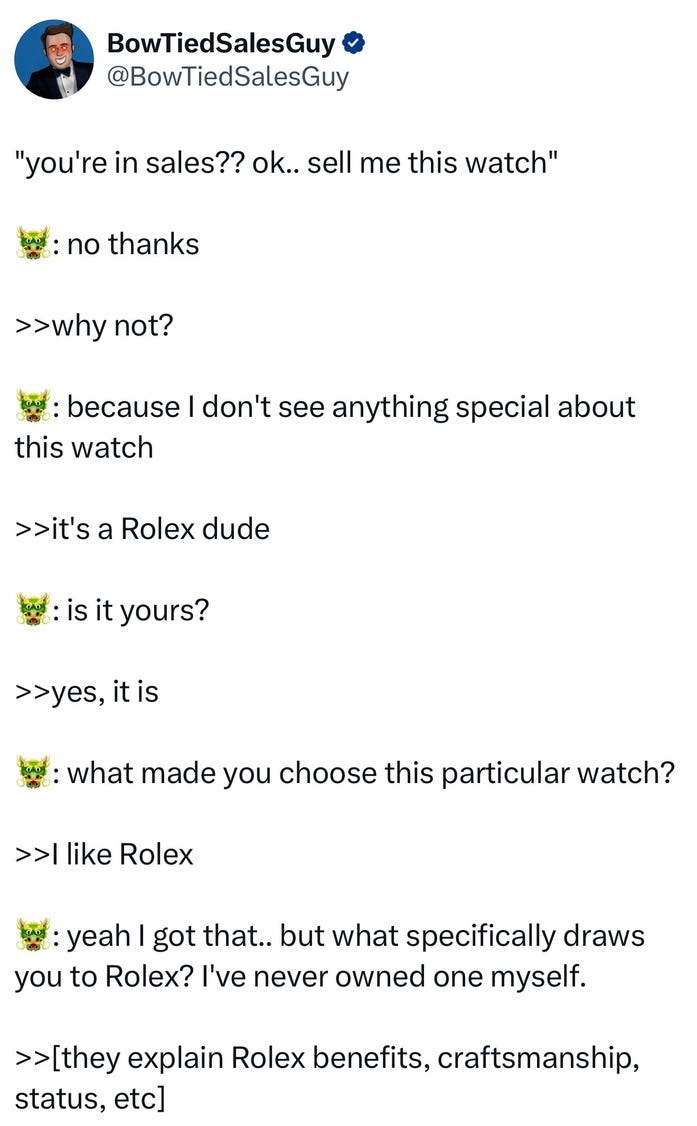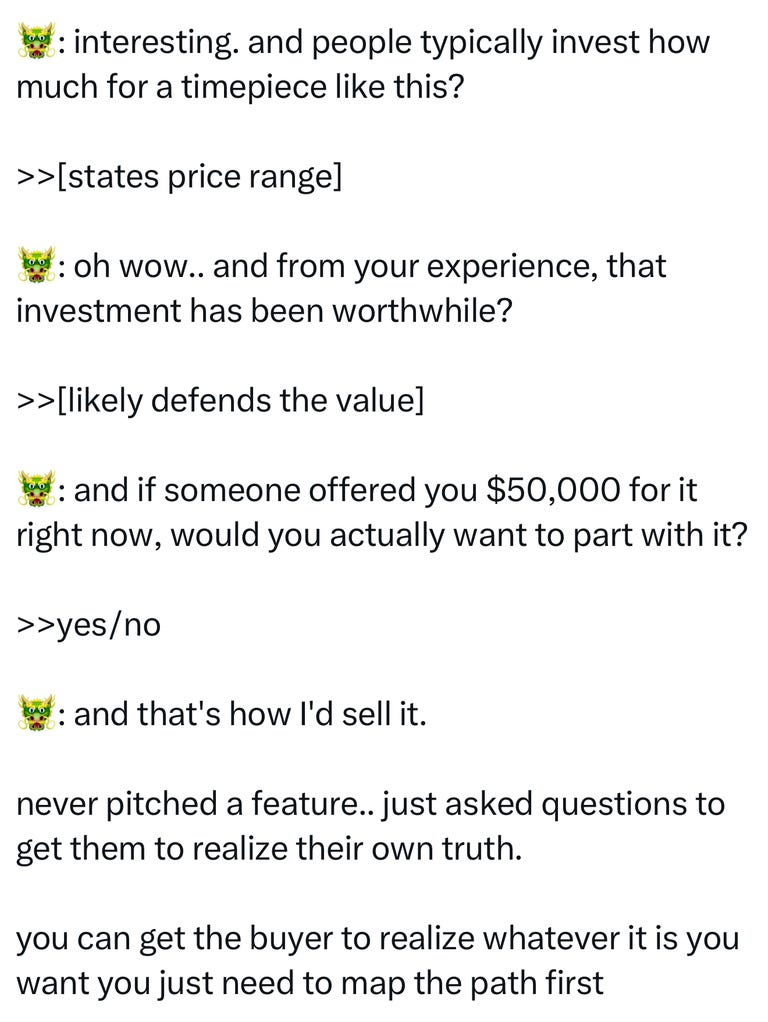"Sell me this watch!"
step by step breakdown
I recently watched a sales guru get hit with the classic “oh you’re in sales? sell me this [item]” request demand that we all have experienced at one point or another.
The interviewer asked him, on the spot, to sell him an item. Being put on the spot is hard no matter who you are.
However, I did notice a few things in this gurus approach:
He started with basic fact finding questions. Some were good i.e “Do you own one already?” and some more traditional i.e “Which color is your favorite?”
He asked leading questions in the hopes that he can recreate the same pattern of past buying behavior in the present i.e “At what point did you realize you wanted one?” → “What point would you need to reach to feel like you need this?”
Those trained in the 🐲 arts can see leading questions coming from a mile away. Not to say they can’t work, but you need to tread carefully with them.
And that was it from the gurus side before he stopped the roleplay.
Watching this guru try to sell the item inspired me to share my approach + my thought process.
In this example, I used a watch:
My thought process
My belief is that my job is to get you to justify buying my solution.
If you can really internalize this belief, then you will be in the right headspace for selling and constructing your “argument”
I don’t mean argument in the sense that I am arguing or trying to convince the buyer of my point, at least not in the traditional sense. Instead, I first start with where I’m trying to guide the conversation.
What am I trying to get this person to realize by the end of our conversation? From there, I can either work backwards or go step by step forward towards that end point.
When salespeople ask me which questions they need to ask, they are focusing on the wrong thing.
The better question is:
🐲: If I want the buyer to realize XYZ on their own, what questions will lead them to that conclusion without me stating it directly?
Most sales meetings feel like they are moving sideways because there is no clear end state or conclusion to work toward. Where are you trying to take this person?
While I often recommend “Next steps or No” as a general conclusion to work towards, the reality is obviously more nuanced. In complex deals, your target conclusion might be simply getting the prospect to recognize that a problem even exists or acknowledge the cost of inaction.
The key is defining what specific realization you want the prospect to reach by the end of the conversation.
In the watch example, what I wanted the buyer to realize was the true value of the watch to them.. not through me telling them why they should value it, but through leveraging their own reasoning process.
Specifically, I wanted them to:
Articulate to me, in their own words, the specific attributes they value in the Rolex. Features, Benefits, etc.
Acknowledge the financial value they place on it.
Recognize that they made a judgement on the watch’s value without me needing to pitch a single feature.
The uniqueness of this approach is that regardless of whether they tell me “Yes” or “No” to selling it for $50k, they will have reached the same realization:
This watch has significant value that they themselves articulated and defended.
Throughout the dialogue I am transferring ownership of the product, and justification for why they should buy, to the person most qualified to make that argument:
The Buyer.
This approach is also unique because the buyer rarely realizes what’s happening in the moment. The entire process is subtle and disarming. They don’t see the persuasion coming or happening, creating ideal conditions for them to convince themselves
Step by Step Breakdown
1. Defy expectations
Those who have gone through my course will identify the Power Frame at the beginning by saying “No thanks”.. this interrupts the Baseline Frame by making them chase me and not the other way around. I need this momentum to continue pulling them in. Them responding with “why not?” is the indicator that they are hooked and now I have my opening.
2. Elicit a defense
Saying “Because I don’t see anything special about this watch” is sharing my reasoning to trigger their natural impulse to change my mind so they can defend their position. They are probably thinking “What an idiot! Doesn’t he know this is a Rolex?!?” Good. I have him right where I want him.
3. Reframing Positions
Instead of me being the owner of the watch that needs to sell it to him. He becomes the owner of it and needs to tell me why he bought it. Asking him if he owns the watch creates the justification needed to make my job easier. He already owns the watch. All I need is to find out why he owns it and what the conditions for buying it were.
4. Line of Questioning
Each question is deliberate and intentional. The aims are to get them to:
Articulate the personal value (“What made you choose this particular watch?”)
Tell me the benefits (“What specifically draws you to Rolex?”) .. the “I’ve never owned one myself” bit is to disarm them by appearing ignorant with the aim of enticing them to share as much information as possible.
Confirm social proof and market value of the Rolex (“People typically invest how much for a timepiece like this?”) .. again continuing to play dumb.
Defend the value using their own experience (“Oh wow.. and from your experience, that investment has been worthwhile?”)
Lock in the “buying decision” (“Would you part with it for $50,000?”)
This sets me up so that no matter what they say they will have made the argument for me.
5. The Cherry on top
“And that’s how I’d sell it” is to also Frame the entire experience as one giant demonstration. Gives the other person that “awe” factor.
Practice
The way you get good at this is by practicing creating dialogues similar to this one. Even if you can’t execute them perfectly in real meetings you will gain a ton of value from doing it anyway as it will build and refine your mental map.
I’ll leave you with a note I shared with one of the Accelerator cohorts:
Give yourself a strong foundation with clear structure and preparation. Really allow yourself to know what you're looking to do in your meetings. And then give yourself the grace to improvise within the structure as the conversation naturally flows.
You improve your odds of success by planning ahead because you already know the range of answers you're going to get based on the questions you ask. Buyers are predictable.
The idea that each buyer is so unique that we can't follow a structure is actually a limiting belief. Yes, you'll occasionally get curveballs. But you can handle those as they come.
This is about making high % choices.
My own sales meetings are mostly predictable. They typically follow 2-3 patterns 90%+ of the time. That predictability is what we're aiming for. The art is making it feel spontaneous.
If you want help with applying any of this in your world, then let’s talk.
Programs & Trainings
The Accelerator
A high intensity 12 week group coaching program. Limited to 10 participants. Through live teachings and active roleplaying, you'll learn how to deeply understand your buyers, ask powerful questions, and be in control of your deals.
More details here:
—
If you’re ready to enroll, you can fill out the form here:
The Chad Salesman Course
My flagship course. A no-BS self study course that transforms average sellers into top performers.






Really good post today. Thank you.
We’ve got some powerful differentiation in our product that is not coming through as well as it should in sales messaging. This article helped me realize why:
We are so excited by our capabilities that we are trying too hard to sell them directly. And that’s keeping the buyer on the defense. And us talking about features vs. competition and blah blah blah.
instead, we should be structuring more thoughtful questions that help the buyer realize he is already making a lot of investments he believes create value. and how frustrated he is that he can’t execute those investments perfectly…
Because he doesn’t have us. With us, he can.
Then we aren’t selling him on “us.” He sells himself on the wisdom of his own process. And just happen to have the best way to reinforce that process.
There are so many times in the pitch too I can act ignorant, have them describe all the ways they’re creating value “if they could just get more accountability”. Etc etc.
Really powerful man. Im gonna write something up for my team about this. Thanks.